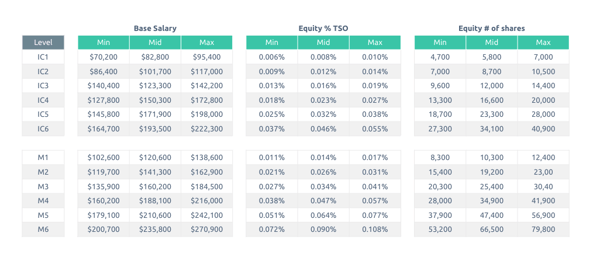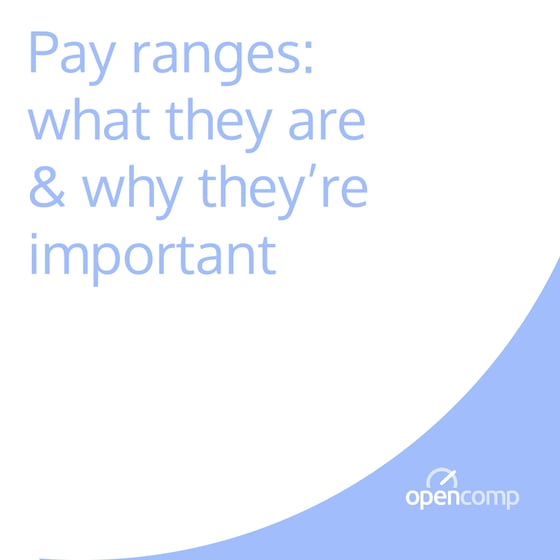Salary ranges are a powerful way for modern companies to address some of the biggest internal and social challenges on the path to IPO and/or continued hyper-growth.
Well-constructed pay ranges help employers convince top talent to accept offers and keep rockstar employees longer – while managing burn and equity dilution. Salary ranges can also help companies answer the growing demand for pay equity and transparency from workers, corporate boards, and state legislators.
What exactly are pay ranges? Salary bands, aka salary bands, set the boundaries for salaries for roles or groups of roles. They’re not arbitrary numbers that bookend a target. Like most things comp related, building pay ranges that are right for your organization requires reliable data, strategy, and foresight.
In this article, we’ll review the things to consider – and avoid – for salary ranges that support your business today and its vision for the future.
When To Progress From Market Pricing To Pay Ranges
Is your company ready for pay ranges? Startup salary bands aren’t crucial when a company is young, has fewer than 50 employees, isn’t yet thinking about promotions or merit increases, and maybe doesn’t even have a dedicated HR pro. Market pricing for individual roles is sufficient. But as the company grows, finding market data for every single role can become laborious.
Your company is ready to move from individual market pricing to pay ranges if:
- You’re making inconsistent offers for similar or related roles based on haphazard criteria like a person’s previous salary.
- You’re making offers that don’t align with your company’s compensation philosophy, the formal document that explains how you plan to pay and reward your employees based on your market, financials, and goals.
- You don’t have a framework for making offers and promotion decisions quickly, a necessity in order to compete in today’s fast-paced market.
What Makes Up A Pay Range
Salary ranges are based on market data, a company’s market positioning, and its compensation philosophy.
A pay range typically includes a low, mid, and high amount for a salary.
The midpoint is the anchor to your compensation philosophy. For instance, if you intend to pay at the 75th percentile, the midpoint will reflect this.
A role can have several levels of progression (such as engineer, senior engineer, and lead engineer) with a pay range for each level.
To construct a pay range, use the following formula:
Benchmark + Level = Market Value/Pay Range
Benchmark: Compares a company’s roles to similar roles at other companies within their industry and the broader marketplace.
Level: Establishes a job’s duties, responsibilities, tasks, and level of authority within an organization’s job hierarchy.
Examples Of A Pay Range Structure
There are a few different ways to group your pay ranges. Below is an example of a completed pay range structure for a role or group of roles. In the left-hand column, “IC” numbers are salary ranges for individual contributors, while “M” numbers are pay ranges for managers.

Considerations And Key Steps For Creating Pay Ranges
Guided by your compensation philosophy, your pay ranges will help tell the story of how your employees will progress through each pay range to the next level for a role. Here are some important things to consider as you construct your pay range structure:
- What’s the criteria for moving people through each range? Will it be based on skills, proficiency, or a mix of both? Here’s an example of how employees would fall into a range based on proficiency.
- Low: Entry-level or new employees whose skills need to be developed
- Mid: Proficient and fully competent in a role
- High: Excelling and ready to take on more responsibilities
- Do you have enough room in a pay range for people to grow, but not so much that there is a potential for internal inequity? You want the ability to give someone a raise without a promotion, otherwise you could create internal leveling issues.
To create your pay ranges, follow these steps:
- Complete market analysis and benchmarking with fresh, relevant data
- Understand your current market position so you understand what you can afford
- Set your market positioning and geographic pay strategy
- Define your compensation philosophy
- Group jobs with similar market reference points into a structure
- Build salary bands and adjust for leveling progression
- Revisit, as needed
Common Pay Range Mistakes To Avoid
Poorly constructed salary bands can lead to problems like excessive cash burn, over-dilution, and pay inequity. To construct pay ranges that make sense for your company, avoid:
- Using comp data from self-reported or stale market surveys that aren’t relevant to your company. The wrong data creates an inaccurate picture of the market.
- Using data filters that don’t account for your company’s specific talent market and where you’re recruiting – or where you are losing people to.
- Using raw market data as salary bands. For instance, a company might say, “Our minimum is the 25th percentile and our max is the 75th percentile, so we pay people in the middle.” But because there’s a lot of variability in market data, percentiles may shift and create a range that’s too narrow or too wide. For more control and stability, identify a percentile and build a boundary of specific salaries around it.
- Not having a compensation philosophy to guide the structure of your salary ranges. We can’t stress this enough: Your compensation philosophy is the foundation for your pay program. Don’t build it without one.
- Making salary ranges too wide and creating job leveling or internal equity problems.
Transparency: How To Share Salary Bands With Candidates And Employees
Pay ranges can simplify and ease the stress of comp-related conversations because they provide a clear framework on which to base discussions. Here are some tips for sharing pay ranges and ongoing comp conversations.
Conversations with job candidates:
- Share the pay range. Whether you share a portion of a range or the whole thing, give candidates an idea of how their pay compares to the market for that role. This sets the foundation for a trusting relationship.
- Explain how the offer reflects your compensation philosophy. Clarify how your company’s goals and values helped shape an offer. This gives the offer context and demonstrates that pay decisions aren’t random. For instance, “We emphasize equity over cash because we believe in the long-term value of this company and we want you to share in that success.”
- Discuss additional compensation opportunities. Talk about how they would get pay increases over time, such as merit increases, bonuses, or periodic refresh cycles.
Conversations with employees:
- Consistency. This is key in compensation. Make sure everyone receives the same message.
- Transparency and education. These two pillars go hand-in-hand, because information without context is meaningless. Share information and help managers and employees understand what it means.
- Open door. Don’t limit pay conversations to the hiring process or annual reviews. Managers should feel comfortable and empowered to talk with employees about compensation whenever a need or question comes up.
When To Reevaluate Your Salary Bands
Set it and forget it doesn’t apply to pay ranges. Evaluate salary ranges periodically to make sure they reflect the market and appropriate to your stage of growth.
- Once a year: Update your pay ranges.
- Twice a year: Check compensation data for hot jobs.
- Ad hoc: Revisit compensation during big company milestones like a fundraise.
- Ongoing: Review your roles and update as needed based on internal trends like an increase in offers at the top of a range. That may be an indication that you need to age your salary ranges sooner than planned.



